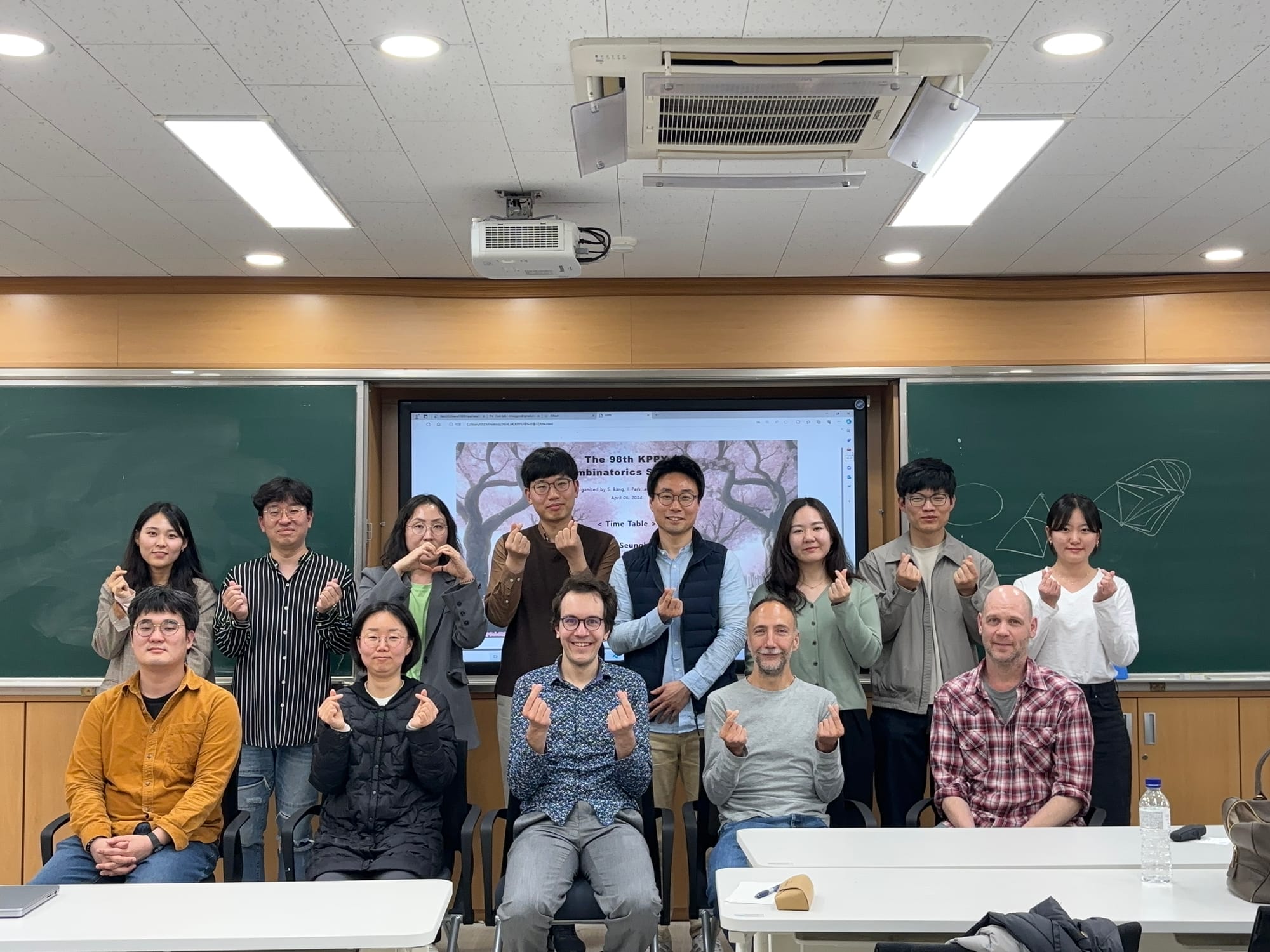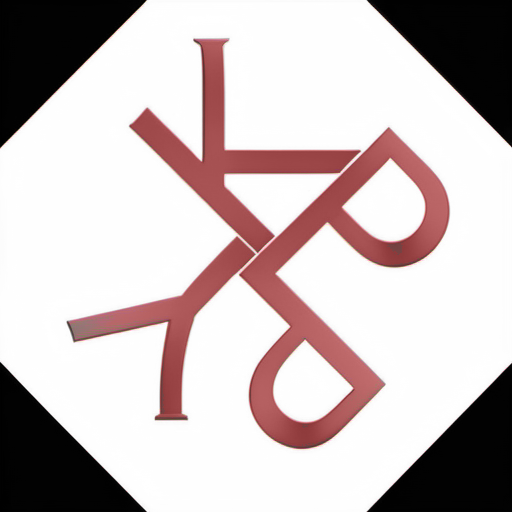KPPY 98

Apr 06, 2024. 11:30am - 5:00pm at KNU (Room 313, Building 209)
| Schedule | ||
| 11:30 |
Seunghun Lee KAIST | Constructions of geometric hypergraphs with high chromatic number and transversal ratio |
| 12:30 | Lunch | |
| 2:00 |
Victor Dalmau University Pompeu Fabra | Right-adjoints of Datalog Programs |
| 3:00 |
Rutger Campbell IBS | Counting well-quasi-ordered down-sets |
| 4:00 |
Eun-Kyung Cho Hanyang University | On the Interval Coloring Impropriety of Graphs |
| 5:00 | Dinner | |
Abstracts
Seunghun Lee
Constructions of geometric hypergraphs with high chromatic number and transversal ratio
Constructions of geometric hypergraphs with high chromatic number and transversal ratio
Given a hypergraph $H=(V,E)$, we say that $H$ is (weakly) $m$-colorable if there is a coloring $c:V\to [m]$ such that every hyperedge of $H$ is not monochromatic. The (weak) chromatic number of $H$, denoted by $\chi(H)$, is the smallest $m$ such that $H$ is $m$-colorable. A vertex subset $T \subseteq V$ is called a transversal of $H$ if for every hyperedge $e$ of $H$ we have $T\cap e \ne \emptyset$. The transversal number of $H$, denoted by $\tau(H)$, is the smallest size of a transversal in $H$. The transversal ratio of $H$ is the quantity $\tau(H)/|V|$ which is between 0 and 1. Since a lower bound on the transversal ratio of $H$ gives a lower bound on $\chi(H)$, these two quantities are closely related to each other.
We present constructions of geometric hypergraphs with high chromatic number and(or) transveral ratio. The ultimate conjecture on this line asks for a construction of $d$-polytopes for every $d\geq 4$ such that the supremum among the transversal ratios of the facet hypergraphs of those $d$-polytopes is eqaul to 1. As intermediate steps towards the conjecture, we will consider constructions regarding transversals and colorings coming from various types of simplicial complexes - neighborly spheres, simplicial complexes which are piecewise-linearly (or geometrically) embeddable in $\mathbb{R}^d$ and so on.
This presentation is based on the two joint work; one with Joseph Briggs and Michael Gene Dobbins, and the other with Eran Nevo.
We present constructions of geometric hypergraphs with high chromatic number and(or) transveral ratio. The ultimate conjecture on this line asks for a construction of $d$-polytopes for every $d\geq 4$ such that the supremum among the transversal ratios of the facet hypergraphs of those $d$-polytopes is eqaul to 1. As intermediate steps towards the conjecture, we will consider constructions regarding transversals and colorings coming from various types of simplicial complexes - neighborly spheres, simplicial complexes which are piecewise-linearly (or geometrically) embeddable in $\mathbb{R}^d$ and so on.
This presentation is based on the two joint work; one with Joseph Briggs and Michael Gene Dobbins, and the other with Eran Nevo.
Victor Dalmau
Right-adjoints of Datalog Programs
Right-adjoints of Datalog Programs
We say that two functors $\Lambda$ and $\Gamma$ between thin categories of relational structures are adjoint if for all structures $A$ and $B$, we have that $\Lambda(A)$ maps homomorphically to B if and only if A maps homomorphically to $\Gamma(B)$. If this is the case $\Lambda$ is called the left adjoint to $\Gamma$ and $\Gamma$ the right adjoint to $\Lambda$. In 2015, Foniok and Tardif described some functors on the category of digraphs that allow both left and right adjoints. The main contribution of Foniok and Tardif is a construction of right adjoints to some of the functors identified as right adjoints by Pultr in 1970. We shall present several recent advances in this direction including a new approach based on the notion of Datalog Program borrowed from logic.
Rutger Campbell
Counting well-quasi-ordered down-sets
Counting well-quasi-ordered down-sets
For a poset arising from combinatorial objects under some substructure relation, we characterize when there are (un)countably-many well-quasi-ordered down-sets.
This is based on joint work with Dillon Mayhew (University of Leeds).
This is based on joint work with Dillon Mayhew (University of Leeds).
Eun-Kyung Cho
On the Interval Coloring Impropriety of Graphs
On the Interval Coloring Impropriety of Graphs
An improper interval (edge) coloring of a graph $G$ is an assignment of colors to the edges of $G$ satisfying the condition that, for every vertex $v \in V(G)$, the set of colors assigned to the edges incident with $v$ forms an integral interval.
An interval coloring is $k$-improper if at most $k$ edges with the same color all share a common endpoint.
The minimum integer $k$ such that there exists a $k$-improper interval coloring of the graph $G$ is the interval coloring impropriety of $G$, denoted by $\mu_{int}(G)$. In this talk, we determine improved upper bounds on the interval coloring impropriety of several classes of graphs, namely 2-trees, iterated triangulations, and outerplanar graphs. Additionally, we investigate the interval coloring impropriety of the corona product of two graphs, $G\odot H$. Finally, we provide a construction of an interval coloring of a subclass of complete multipartite graphs. This provides additional evidence to the conjecture by Casselgren and Petrosyan that $\mu_{int}(G)\leq 2$ for all complete multipartite graphs $G$.
This is a joint work with MacKenzie Carr, Nicholas Crawford, Vesna Iršič, Leilani Pai, and Rebecca Robinson.
The minimum integer $k$ such that there exists a $k$-improper interval coloring of the graph $G$ is the interval coloring impropriety of $G$, denoted by $\mu_{int}(G)$. In this talk, we determine improved upper bounds on the interval coloring impropriety of several classes of graphs, namely 2-trees, iterated triangulations, and outerplanar graphs. Additionally, we investigate the interval coloring impropriety of the corona product of two graphs, $G\odot H$. Finally, we provide a construction of an interval coloring of a subclass of complete multipartite graphs. This provides additional evidence to the conjecture by Casselgren and Petrosyan that $\mu_{int}(G)\leq 2$ for all complete multipartite graphs $G$.
This is a joint work with MacKenzie Carr, Nicholas Crawford, Vesna Iršič, Leilani Pai, and Rebecca Robinson.
